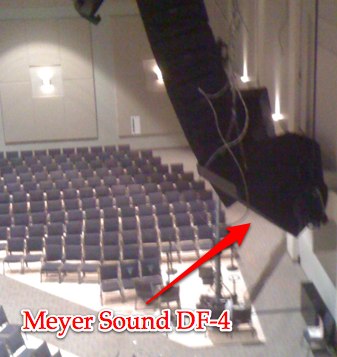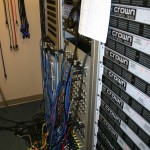
Year of the System 2010: PA – Anatomy: Filling In The Gaps
Rounding out our main floor loudspeakers are a series of fill speakers. These provide needed coverage to fill some holes where the mains don’t reach.

First up are the downfills. Hanging near the bottom and to the side of each array are 2 Meyer Sound DF-4 downfill speakers. The DF-4 is essentially a dedicated downfill speaker that closely matches the performance of an MSL-4. The downfills cover the area near the bottom of the array and extend to where the coverage of the arrays starts. In our case, using DF-4’s as downfills with a line array is not something you typically see and somewhat unconventional. Typically additional boxes are added to the array and the array becomes more curved near the bottom, however, there are some challenges created by doing this. Adding more splay to a line array can basically create inconsistency within the coverage of your array. The more splay, the more you hear the fingering of sound that takes place. The other difficulty is that the vertical coverage in most line array boxes is very narrow–no more than 7 degrees in the case of our MICA’s–which requires even more boxes to provide adequate coverage. Since the boxes are closer to the listener, it is increasingly more difficult to provide enough room for the pattern of the box to open up and provide adequate coverage. In our particular case, sightlines to the video screens precluded us from adding additional boxes to the bottom of the arrays…and don’t think we didn’t try….. The DF-4’s, however, allow us to retain our video sight lines and avoid the sonic compromises of exaggerating the splay in our arrays.
Next up are our outfills. Each of the front sections on our far sides is covered by a single MSL-4. The seats in these sections are literally perpendicular to the stage(as seen in the DF-4 photo). The MSL-4 outfills were the only loudspeakers carried over from our previous system as they were added to the system in late Summer 2007. Even with the wide coverage provided by the MICA’s, there is no way for them to open wide enough to cover the far sides. While using a smaller array might seem like the assumed way to go to match the mains, the wide pattern of another array would have put a lot of energy on the front wall creating unnecessary reflections.

Meyer Sound JM-1P
Finally, we have what I refer to as the Bermuda Triangle-fills. These fills are part of the consequences that happen when the real world meets the design world. Towards the end of the design phase, the main arrays were moved forward a few feet into the room in order to accommodate future plans to extend our stage into the room, and leaving the arrays in their original locations gave us a few concerns. The reality is that when you stand directly beneath a line array, there are some funky artifacts that happen, and we wanted to minimize their potential effects on microphones that would now be in the same horizontal plane as the arrays. A consequence of moving the arrays forward into the room was the creation of an area we started referring to as the Bermuda Triangle. It was a coverage hole between the coverage of the array and the MSL-4 outfills. Fortunately we were able to acquire a couple of the new JM-1P’s that were in town to add as our Bermuda Triangle-fills.
The JM-1P is a great box for this task thanks to it’s very narrow 20 degree horizontal coverage. Aiming these was a lot of fun because you can literally sight down the side of the box knowing the coverage runs right with the side of the box. They’re also nice because the horn design is essentially a MILO horn giving it a sonic signature very close to that of our MICA’s.
So that just about wraps up the PA hardware, but I’ve still got plenty of stuff about the projects to come. I honestly feel like there has been more work to be done on the back end of the install as we are working in the system. It has definitely forced me–in a good way–to rethink some mixing strategies, but I’m going to hold off on that stuff until I get some things figured out a little better. Up next should be about one of my favorite parts of the upgrade: our amp room refit. I’ve been thrilled with how the whole thing turned out, and as soon as I get the final video tour done I’ll try and get things up.

 Next Post
Next Post



A little curious why you went with hung under-fill speakers instead of front fill speakers that you can place at the front edge of the stage facing the audience? When we moved into our building it took several months to get the under fills tuned because of feedback issues associated with them. Looking back, we sort of wish we had gone for an in-stair front fill speaker or a some really low profile speakers we could set at the front of the stage.
We did use front-fill speakers. They are currently on the stairs and will get sunk in at some point in the future.
http://goingto11.com/?p=741
Aww those tiny speakers are so cute. What do they want to be when they grow up?